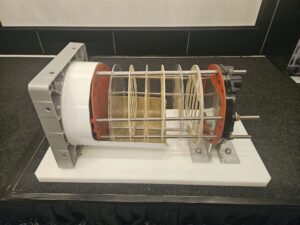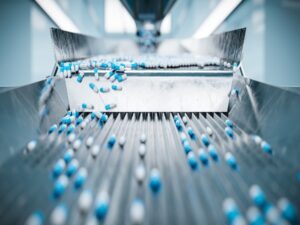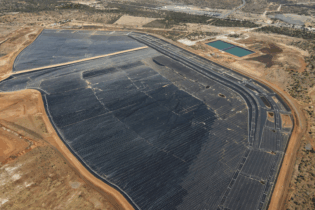Continuous electro deionisation (CEDI) is a water treatment process that uses a combination of ion-exchange resins, ion-exchange membranes and direct current to continuously deionize water without the need for chemicals. This is used to produce ultrapure water.
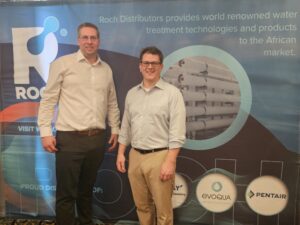 Ionpure first commercialised CEDI for water purification in 1987. Since then, the company has continued to evolve and bring out new technologies. It has undergone a number of transitions and was recently acquired by Xylem, while trading under the name Evoqua Water Technologies.
Evolution of deionisation
Deionisation is typically the last process to remove any remaining dissolved solids (such as sodium chloride) in water.
Previously, the only option available was chemically regenerated ion exchange resins where the mixed-bed stage was preceded by separate units for cation and anion exchange.
In a bid to further improve water quality, reverse osmosis (RO) was introduced to reduce total organic carbon as well as chemical usage in water treatment systems. This was followed by the mixed bed stage.
“As the cost of RO started to drop, the uptake of the technology increased. RO pulls out the majority of bulk ions and organics and prepares the water for CEDI technology,” says Patrick Buzzell, director: Product Management, Ionpure products.
What is so great about CEDI?
Ionpure first commercialised CEDI for water purification in 1987. Since then, the company has continued to evolve and bring out new technologies. It has undergone a number of transitions and was recently acquired by Xylem, while trading under the name Evoqua Water Technologies.
Evolution of deionisation
Deionisation is typically the last process to remove any remaining dissolved solids (such as sodium chloride) in water.
Previously, the only option available was chemically regenerated ion exchange resins where the mixed-bed stage was preceded by separate units for cation and anion exchange.
In a bid to further improve water quality, reverse osmosis (RO) was introduced to reduce total organic carbon as well as chemical usage in water treatment systems. This was followed by the mixed bed stage.
“As the cost of RO started to drop, the uptake of the technology increased. RO pulls out the majority of bulk ions and organics and prepares the water for CEDI technology,” says Patrick Buzzell, director: Product Management, Ionpure products.
What is so great about CEDI?
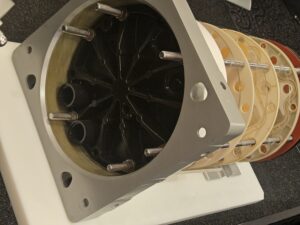 Unlike traditional ion exchange methods that require periodic regeneration of the resin beds, CEDI operates continuously without the need for regeneration. Regeneration is a process that takes ion exchange resin beds that are exhausted (fully loaded) and removes ions that have been picked up during the in-service cycle so the resin can continue to be used. This involves the use of hydrochloric or sulfuric acid as well as sodium hydroxide (caustic acid).
“With CEDI, there is no need to use the hazardous regeneration chemicals, making the entire treatment process intrinsically safer and environmentally friendly. There is no need to manage the pH levels all day and there is limited downtime,” states Buzzell.
Ion exchange resin is a batch process, therefore there is a threshold or a minimum water quality that needs to be maintained. As the resin beds begin to exhaust, the water quality will drop. There is a breakthrough of ions at the end of the service cycle and a rinse out of regenerant at the beginning of the next service cycle. Usually, the detection of a weakly charged contaminant like silica is an early indicator that the resin bed is beginning to exhaust. At that point in time, a new resin must be used, or regeneration must take place. This interrupts the treatment process.
Buzzell adds that when using CEDI technology, the water quality will remain consistent for the life of the product, creating a stable operation. “The longevity of CEDI technology largely depends on several factors, including maintenance practices, operating conditions, and the quality of the feed water. In general, CEDI systems can operate continuously, with an average lifespan of five years.”
Unlike traditional ion exchange methods that require periodic regeneration of the resin beds, CEDI operates continuously without the need for regeneration. Regeneration is a process that takes ion exchange resin beds that are exhausted (fully loaded) and removes ions that have been picked up during the in-service cycle so the resin can continue to be used. This involves the use of hydrochloric or sulfuric acid as well as sodium hydroxide (caustic acid).
“With CEDI, there is no need to use the hazardous regeneration chemicals, making the entire treatment process intrinsically safer and environmentally friendly. There is no need to manage the pH levels all day and there is limited downtime,” states Buzzell.
Ion exchange resin is a batch process, therefore there is a threshold or a minimum water quality that needs to be maintained. As the resin beds begin to exhaust, the water quality will drop. There is a breakthrough of ions at the end of the service cycle and a rinse out of regenerant at the beginning of the next service cycle. Usually, the detection of a weakly charged contaminant like silica is an early indicator that the resin bed is beginning to exhaust. At that point in time, a new resin must be used, or regeneration must take place. This interrupts the treatment process.
Buzzell adds that when using CEDI technology, the water quality will remain consistent for the life of the product, creating a stable operation. “The longevity of CEDI technology largely depends on several factors, including maintenance practices, operating conditions, and the quality of the feed water. In general, CEDI systems can operate continuously, with an average lifespan of five years.”How does CEDI work?
CEDI combines two processes: ion exchange and electrodialysis. The positively charged electrodes will attract negatively charged ions and the negatively charged electrodes will attract the positively charged ions. CEDI utilises ion exchange membranes and electricity to remove ions from water. The cation transfer membranes only allow positive ions to move through them and an anion transfer membrane only allows negative charges to move through. The membranes are impermeable to water. The water flows past and not through the membrane while only the ions move through the membranes. There are alternating cation and anion exchange membranes, as the ions move across the CEDI module.
The spaces in between these membranes are configured to create liquid flow compartments with inlets and outlets. The compartments are bound by an anion membrane facing the positively charged anode and a cation membrane facing the negatively charged cathode. These are diluting compartments. The compartments bound by an anion membrane facing the cathode and a cation membrane facing the anode are concentrating compartments.
To facilitate ion transfer in low ionic concentration solutions, the dilute compartments are filled with ion exchange resins. The ion exchange resin attracts the ions from the water. The DC electric field helps to transport the ions from the ion exchange resin within the diluting compartment towards the ion selective membrane and into the concentrating compartment. This process effectively removes the ions from the diluting stream into the concentrating (waste) stream. The ions effectively get stuck between the membranes, creating the waste stream. Between 5% to 10% of the flow is diverted into the waste stream to flush these ions away. The waste stream can be safely discharged, reused or recycled back in front to the RO feed to maximise the full CEDI recovery.
“It is important to remember that this is not a pressure driven process. This is very different from RO that is pressure driven. CEDI requires an electric field. Ionpure’s technologies run on DC power, providing up to 600 volts and 13 amps output. We have also developed our own power controllers through collaborating with other partners. It is the amperage that moves the ions through the membranes,” explains Buzzell.
The design flow for a full sized Ionpure VNX-MAX module is 15 m3/hour, with the minimum at 7.5 m3/hour and maximum at 22 m3/hour. “The higher the flow rate, the less time there is for the electric field to work on the ions. So generally speaking, the lower the flow rate, the better the performance. But if the flow is too low, the channels will not fill up adequately and there will be inadequate flow distribution,” he adds.
Higher loads of CO2 negatively affect the ultimate quality of the water and is accounted for with Feedwater Conductivity Equivalent (FCE) or load. For example, 10 µS/cm of load will give better water quality than 40 µS/cm of load. “Most of our modules go up to 40 µS/cm of load. If the loading is greater than that, the module will continue to operate, but we cannot predict the quality of the water at the end of the process,” says Buzzell.
Conclusion
CEDI is a compelling option for various water treatment applications, particularly in industries where water purification is critical. It is an efficient and cost-effective method for producing high-purity water with low levels of dissolved solids. It offers several advantages over traditional ion exchange processes, including high efficiency, low operating costs, low maintenance requirements, and flexibility in terms of scalability and space requirements. This makes it widely used in power production (boiler feed), science-intensive industries, pharmaceuticals, food & beverage, general industry, and production of high-purity substances.
Contact Roch for more information. https://roch.co.za/
The positively charged electrodes will attract negatively charged ions and the negatively charged electrodes will attract the positively charged ions. CEDI utilises ion exchange membranes and electricity to remove ions from water. The cation transfer membranes only allow positive ions to move through them and an anion transfer membrane only allows negative charges to move through. The membranes are impermeable to water. The water flows past and not through the membrane while only the ions move through the membranes. There are alternating cation and anion exchange membranes, as the ions move across the CEDI module.
The spaces in between these membranes are configured to create liquid flow compartments with inlets and outlets. The compartments are bound by an anion membrane facing the positively charged anode and a cation membrane facing the negatively charged cathode. These are diluting compartments. The compartments bound by an anion membrane facing the cathode and a cation membrane facing the anode are concentrating compartments.
To facilitate ion transfer in low ionic concentration solutions, the dilute compartments are filled with ion exchange resins. The ion exchange resin attracts the ions from the water. The DC electric field helps to transport the ions from the ion exchange resin within the diluting compartment towards the ion selective membrane and into the concentrating compartment. This process effectively removes the ions from the diluting stream into the concentrating (waste) stream. The ions effectively get stuck between the membranes, creating the waste stream. Between 5% to 10% of the flow is diverted into the waste stream to flush these ions away. The waste stream can be safely discharged, reused or recycled back in front to the RO feed to maximise the full CEDI recovery.
“It is important to remember that this is not a pressure driven process. This is very different from RO that is pressure driven. CEDI requires an electric field. Ionpure’s technologies run on DC power, providing up to 600 volts and 13 amps output. We have also developed our own power controllers through collaborating with other partners. It is the amperage that moves the ions through the membranes,” explains Buzzell.
The design flow for a full sized Ionpure VNX-MAX module is 15 m3/hour, with the minimum at 7.5 m3/hour and maximum at 22 m3/hour. “The higher the flow rate, the less time there is for the electric field to work on the ions. So generally speaking, the lower the flow rate, the better the performance. But if the flow is too low, the channels will not fill up adequately and there will be inadequate flow distribution,” he adds.
Higher loads of CO2 negatively affect the ultimate quality of the water and is accounted for with Feedwater Conductivity Equivalent (FCE) or load. For example, 10 µS/cm of load will give better water quality than 40 µS/cm of load. “Most of our modules go up to 40 µS/cm of load. If the loading is greater than that, the module will continue to operate, but we cannot predict the quality of the water at the end of the process,” says Buzzell.
Conclusion
CEDI is a compelling option for various water treatment applications, particularly in industries where water purification is critical. It is an efficient and cost-effective method for producing high-purity water with low levels of dissolved solids. It offers several advantages over traditional ion exchange processes, including high efficiency, low operating costs, low maintenance requirements, and flexibility in terms of scalability and space requirements. This makes it widely used in power production (boiler feed), science-intensive industries, pharmaceuticals, food & beverage, general industry, and production of high-purity substances.
Contact Roch for more information. https://roch.co.za/


